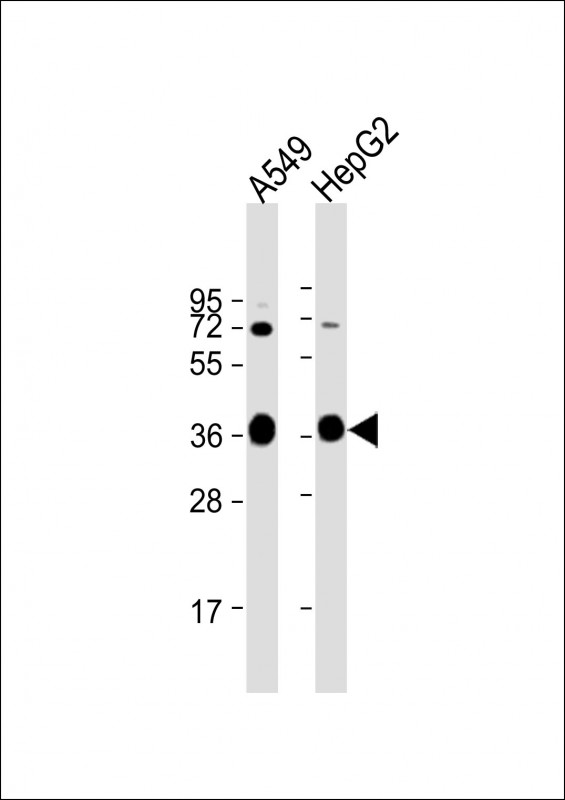产品名称
AKR1C3 Rabbit Polyclonal Antibody (Center)
别名
Aldo-keto reductase family 1 member C3, 1---, 17-beta-hydroxysteroid dehydrogenase type 5, 17-beta-HSD 5, 3-alpha-HSD type II, brain, 3-alpha-hydroxysteroid dehydrogenase type 2, 3-alpha-HSD type 2, Chlordecone reductase homolog HAKRb, Dihydrodiol dehydrogenase 3, DD-3, DD3, Dihydrodiol dehydrogenase type I, HA1753, Indanol dehydrogenase, Prostaglandin F synthase, PGFS, Testosterone 17-beta-dehydrogenase 5, Trans-1,2-dihydrobenzene-1,2-diol dehydrogenase, AKR1C3, DDH1, HSD17B5, KIAA0119, PGFS
存储缓冲液
Purified polyclonal antibody supplied in PBS with 0.09% (W/V) New type preservative N. This antibody is purified through a protein A column, followed by peptide affinity purification.
Human Gene ID
NP_001240837.1;NP_003730.4
Human Swissprot No.
P42330
特异性
This AKR1C3 antibody is generated from rabbits immunized with a KLH conjugated synthetic peptide between 107-135 amino acids from the Central region of human AKR1C3.
稀释度
WB~~1:1000;IHC-P~~1:100~500
运输及保存条件
Maintain refrigerated at 2-8°C for up to 2 weeks. For long term storage store at -20°C in small aliquots to prevent freeze-thaw cycles.
背景介绍
This gene encodes a member of the aldo/keto reductase
superfamily, which consists of more than 40 known enzymes and
proteins. These enzymes catalyze the conversion of aldehydes and
ketones to their corresponding alcohols by utilizing NADH and/or
NADPH as cofactors. The enzymes display overlapping but distinct
substrate specificity. This enzyme catalyzes the reduction of
prostaglandin (PG) D2, PGH2 and phenanthrenequinone (PQ), and the
oxidation of 9alpha,11beta-PGF2 to PGD2. It may play an important
role in the pathogenesis of allergic diseases such as asthma, and
may also have a role in controlling cell growth and/or
differentiation. This gene shares high sequence identity with three
other gene members and is clustered with those three genes at
chromosome 10p15-p14.
组织表达
Expressed in many tissues including adrenal gland, brain, kidney, liver, lung, mammary gland, placenta, small intestine, colon, spleen, prostate and testis. High expression in prostate and mammary gland. In the prostate, higher levels in epithelial cells than in stromal cells. In the brain, expressed in medulla, spinal cord, frontotemporal lobes, thalamus, subthalamic nuclei and amygdala. Weaker expression in the hippocampus, substantia nigra and caudate
功能
Cytosolic aldo-keto reductase that catalyzes the NADH and NADPH-dependent reduction of ketosteroids to hydroxysteroids. Acts as a NAD(P)(H)-dependent 3-, 17- and 20-ketosteroid reductase on the steroid nucleus and side chain and regulates the metabolism of androgens, estrogens and progesterone (PubMed:
10622721, PubMed:
11165022, PubMed:
7650035, PubMed:
9415401, PubMed:
9927279). Displays the ability to catalyze both oxidation and reduction in vitro, but most probably acts as a reductase in vivo since the oxidase activity measured in vitro is inhibited by physiological concentration of NADPH (PubMed:
14672942, PubMed:
11165022). Acts preferentially as a 17- ketosteroid reductase and has the highest catalytic efficiency of the AKR1C enzyme for the reduction of delta4-androstenedione to form testosterone (PubMed:
20036328). Reduces prostaglandin (PG) D2 to 11beta-prostaglandin F2, progesterone to 20alpha-hydroxyprogesterone and estrone to 17beta-estradiol (PubMed:
15047184, PubMed:
20036328, PubMed:
10622721, PubMed:
11165022, PubMed:
10998348, PubMed:
19010934). Catalyzes the transformation of the potent androgen dihydrotestosterone (DHT) into the less active form, 5-alpha-androstan-3-alpha,17-beta-diol (3-alpha-diol) (PubMed:
10998348, PubMed:
14672942, PubMed:
11165022, PubMed:
7650035, PubMed:
9415401, PubMed:
10557352). Displays also retinaldehyde reductase activity toward 9-cis-retinal (PubMed:
21851338).



